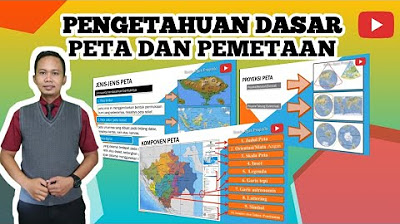KOMPONEN PETA #geography #education #kurikulummerdeka
Summary
TLDRThis educational video script introduces viewers to the components of a map, starting with the title which provides essential information about the map's content. It then explains the map's border, orientation, scale, and inset map, which adds clarity. The script also covers the legend, explaining symbols and colors used to represent different features, and the importance of map coordinates and symbols for conveying information. Lettering and the use of color to differentiate map features are also discussed. The script concludes with the significance of the map's source data and the mapmaker, emphasizing the accuracy and relevance of the map's information.
Takeaways
- 😀 The first component of a map is the title, which provides essential information about the map's content.
- 🗺️ The border or edge of the map is a line that outlines the map's perimeter, meeting at the corners.
- 🧭 Orientation or compass rose indicates direction, typically with an arrow pointing north.
- 📏 Scale represents the ratio of distances on the map to actual distances, with three types: numerical, linear, and verbal.
- 🔍 Inset maps are smaller maps that provide additional clarity on specific areas within the main map.
- 📚 Legends explain the symbols and colors used on the map to ensure easy understanding of the depicted information.
- 🌐 Coordinates relate to the map's placement on the Earth's grid system, using latitude and longitude.
- 🏞️ Symbols on a map represent various features, such as geometric, pictorial, line, color, and field symbols, and should be simple and clear.
- ✍️ Lettering on a map includes all meaningful text, with different styles like capital, lowercase, and italics.
- 🎨 Colors on a map are used to highlight differences between objects, such as land, water bodies, vegetation, and human-made structures.
- 📜 The source of data and the year of map creation are important for understanding the accuracy and relevance of the map's information.
- 👤 The map's creator, such as an individual or institution, is credited for the map's production, ensuring accountability and reference.
Q & A
What is the first component of a map that readers typically look at?
-The first component of a map that readers typically look at is the title. The title provides information about what the map contains, such as 'Digital Topographic Map of Indonesia'.
What is the purpose of map borders?
-Map borders, or edges, are lines that are located at the edge of the map. They meet at the corners with adjacent borders, helping to define the boundaries of the map's area.
What is orientation and how is it usually represented on a map?
-Orientation is a guide to direction, typically represented by an arrow pointing to the north. It helps users understand the direction on the map.
What is the function of a map scale and what are the three forms of scale presentation?
-A map scale is a ratio representing the relationship between a distance on the map and the actual distance on the ground. The three forms of scale presentation are numerical scale, line scale, and verbal scale.
What is an inset map and what is its purpose?
-An inset map is a smaller map that provides additional clarity on a specific area within the main map. It is used to explain the features of a particular region in more detail.
What is a legend on a map and why is it important?
-A legend on a map is a key that explains all the symbols used on the map. It is important because it helps users understand the meaning behind the symbols and colors used to represent different features.
How are coordinates related to a map and what do they typically represent?
-Coordinates on a map are related to the grid system of latitude and longitude lines. They help pinpoint exact locations on the map using degrees of latitude and longitude.
What is the purpose of map symbols and what types of symbols are commonly used?
-Map symbols are used to represent features that are visible or invisible on the map in an informative way. Common types of symbols include geometric, pictorial, line, color, and field symbols.
What is lettering on a map and what are the different types of lettering styles?
-Lettering on a map refers to all meaningful texts present on the map. Different types of lettering styles include capital letters, lowercase letters, a combination of both, and styles such as upright and italic.
How does the use of color on a map help in distinguishing different features?
-The use of color on a map helps to highlight differences between objects, such as land, water bodies, vegetation, and human-made structures. Different colors are used to represent different features, making them easily distinguishable.
Why is it important to include data sources and the year of map creation on a map?
-Including data sources and the year of map creation is important because it provides assurance about the accuracy of the information and helps readers analyze trends and changes over time.
Who is typically credited as the map maker and what does this indicate?
-The map maker is credited as the individual or institution that created the map. This indicates the authority and source of the map's content, such as 'Pemerintah Kabupaten Bekasi' in the example provided.
Outlines

This section is available to paid users only. Please upgrade to access this part.
Upgrade NowMindmap

This section is available to paid users only. Please upgrade to access this part.
Upgrade NowKeywords

This section is available to paid users only. Please upgrade to access this part.
Upgrade NowHighlights

This section is available to paid users only. Please upgrade to access this part.
Upgrade NowTranscripts

This section is available to paid users only. Please upgrade to access this part.
Upgrade NowBrowse More Related Video
5.0 / 5 (0 votes)





